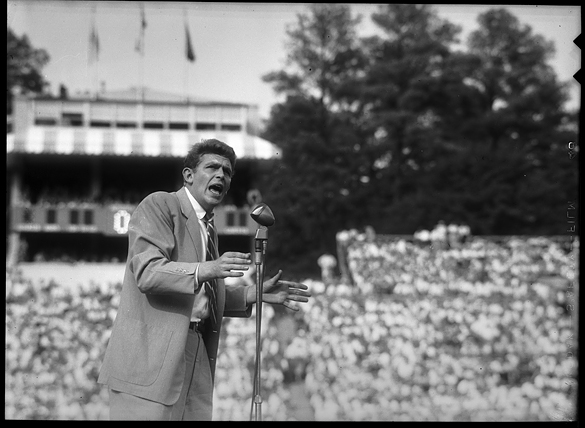
The news is making its way around the world that Andy Griffith passed away this morning. Here’s an excerpt from the chapter “ANDY GRIFFITH: What It Truly Was, Was . . .” in the book Making a Difference in North Carolina by Hugh Morton and Edward L. Rankin Jr. Rankin wrote the chapter on Griffith.
How did Andy Griffith get his big break in show business?
Well, what it was, was . . . a lucky combination of things—an engaging talent, a need for some low-budget entertainment and an enterprising record producer looking for a hit.
Here’s the story, as related by Hugh Morton and Orville Campbell:
In 1950, Morton helped found the Southern Short Course in Press Photography and in planning the first meeting in Chapel Hill he asked Russ Grumman, UNC extension director, to suggest some inexpensive entertainment for the dinner meeting. Grumman recommended a young UNC graduate student and PlayMaker who would do some recitations for $25 and he was booked.
Orville Campbell, long-time friend and Chapel Hill newspaper publisher, had printed the Short Course program and Morton invited Campbell to the dinner. Campbell was also a lyric writer, had produced, with Hank Beebe, the successful record, “All the Way Choo Choo,” and was trying to break into the record business in a big way.
When the young graduate student/PlayMaker appeared, he recited “Romeo and Juliet” and “What It Was, Was Football. To quote Morton, “he tore the place up . . . really tore the place up!” Neither Morton nor Campbell had ever heard of Andy Griffith and were overwhelmed with his performance.
Campbell rushed up to Griffith after the program, introduced himself and said, “we’ve got to make a record of this!” Griffith grinned and replied, “Well, Mr. Campbell, if you’ve got the money, I’ve got the time.” Campbell admits now he had no idea why he acted so impulsively then—but he is glad he did.
The comedy monologue was recorded at six live performances before Campbell was satisfied that he had captured its rustic humor at its very best. The version selected was actually performed before a large and lively audience of insurance sales people and brought down the house with laughter.
The rest is entertainment—and North Carolina history. . . .
We have featured Andy Griffith on several occasions here at A View to Hugh, including a post about Campbell on June 8th with a photograph of Campbell and Griffith arm in arm taken in 1956. You can read those posts using the search box in the upper right corner by entering “Andy Griffith.”
Coincidentally, we already have a Jack Hilliard post scheduled for tomorrow on “The Lost Colony,” America’s first outdoor symphonic drama that is celebrating its 75th anniversary on July 4th, 2012. Griffith joined the play’s cast in 1947. In the mean time, there are currently seventeen photographs of Andy Griffith online from the Hugh Morton Collection. Have a look . . .

At tonight’s (7/3) performance of “The Lost Colony,” they are planning what is called a “standard theatre” tribute for Andy Griffith… there will be one minute of silence, with all theatre lights dark.
The July/August, 2012 issue of “The Carolina Alumni Review” has a look back at Andy Griffith…with a Morton photo.
http://www.carolinaalumnireview.com/carolinaalumnireview/20120708/?sub_id=0BmHm0AWNyDK&pg=1#pg68